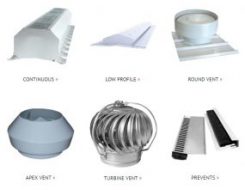The Correct Vents for Your Building’s Ventilation System
Every metal building needs to have an adequate ventilation system, no matter the season. In the summer heat, ventilation is key to moderate temperature, create air movement and cut down on stale air. Just as important, in the cooler months, vents are essential to reducing condensation which can deteriorate the building.

With ventilation options that can be used on roofs and in attic spaces and walls, there are many options that can ensure you have work that flows.
Deciding What Products Work for Your Building
Size: Depending on the size and layout of your building, you will need a certain amount of ventilators to optimize the air flow. Once you do the math for your particular amount of interior space, you have to include the people and equipment that will be working inside the building.
Airflow Capacity: When choosing products to vent your metal building, you have to consider your desired or required volume of air flow. While some products allow for a continuous flow of air, others have to be manually adjusted and some are controlled by electricity.
Aesthetics: There are a range of products available that blend in with the ridge of your building’s roof with compact or low profiles. Additionally, there are optional finishes that can be applied to certain products to match your building.
With many ventilator options, Metallic Products can help you decide what products are correct for your building’s ventilation needs
Don’t waste the time, money and labor that goes in to constructing a metal building with subpar ventilation and accessories. Metallic Products offers American-made, Florida Approved vents and accessories for a range of ventilation system needs. Contact us today for more information.



